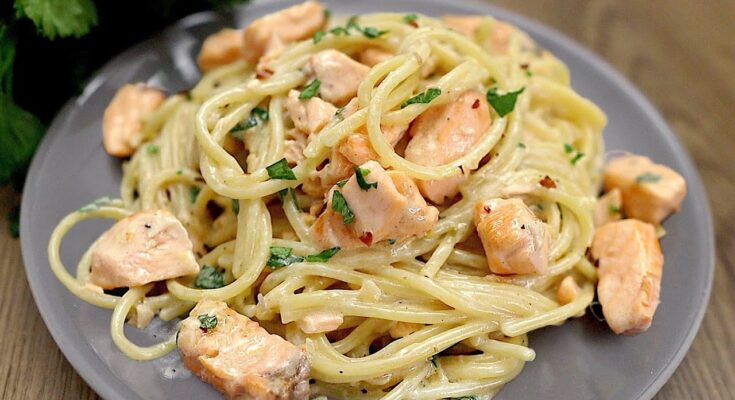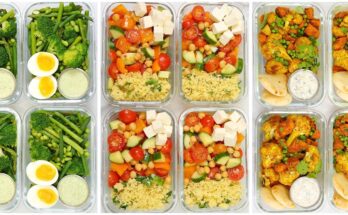Salmon Pasta Recipe: Salmon pasta is the perfect balance of hearty, creamy, and light flavors, making it an ideal choice for both quick weekday dinners and elegant dinner parties. Not only is this dish packed with protein and omega-3 fatty acids from the salmon, but it’s also incredibly versatile—you can customize it to suit your taste. Whether you’re a pasta enthusiast or just looking for a new way to enjoy seafood, this recipe will quickly become a favorite in your household.
Let’s dive into the details and create a delicious salmon pasta step by step!
Ingredients for Salmon Pasta
To make the perfect salmon pasta, you’ll need a handful of fresh and flavorful ingredients. Here’s what you’ll need:
For the Salmon:
- 2 fillets of fresh salmon (skin-on or skinless)
- 1 teaspoon olive oil
- 1 teaspoon salt
- ½ teaspoon black pepper
- 1 tablespoon lemon juice
For the Sauce:
- 2 tablespoons butter
- 2 cloves garlic, minced
- 1 cup heavy cream (or substitute with half-and-half)
- ½ cup grated parmesan cheese
- 1 teaspoon dried dill or fresh parsley
- Zest of 1 lemon
For the Pasta:
- 300g of your favorite pasta (spaghetti, penne, or fettuccine work great)
- Water for boiling
- 1 teaspoon salt
Optional Garnishes:
- Chopped parsley
- Extra parmesan cheese
Pro Tip: Always go for fresh, high-quality salmon and pasta to ensure the best taste and texture. For a lighter option, you can swap heavy cream with Greek yogurt.
Equipment You’ll Need
Before getting started, make sure you have the right tools on hand:
- Non-stick skillet or frying pan
- Large pot for boiling pasta
- Cutting board and knife
- Tongs for tossing the pasta
- Microplane or zester (for lemon zest)
- Wooden spoon for stirring
Preparing the Salmon
Start by preparing the salmon, which is the star of the dish.
- Clean the Salmon: Rinse the fillets under cold water and pat them dry with paper towels. If the skin is on, leave it for now—it helps keep the fish moist while cooking.
- Season Generously: Rub the salmon with olive oil, then sprinkle salt, pepper, and lemon juice evenly across both sides.
- Cook the Salmon: Heat a non-stick skillet over medium heat and place the salmon fillets skin-side down. Cook for 3-4 minutes on each side until the salmon is golden and flakes easily with a fork.
- Break into Chunks: Once the salmon has cooled slightly, use a fork to break it into bite-sized pieces, removing any skin if needed.
Choosing the Perfect Pasta
The type of pasta you use can make or break this dish. Here’s how to choose the best one:
- Long Pasta (Spaghetti or Fettuccine): These work well for creamy sauces, as they coat the noodles beautifully.
- Short Pasta (Penne or Rigatoni): Perfect for catching chunks of salmon and sauce in their ridges.
Cook the pasta according to the package instructions, but always aim for al dente (firm to the bite). This will prevent it from becoming mushy when tossed with the sauce.
Pro Tip: Reserve 1 cup of pasta water before draining—it’s a game-changer for adjusting the sauce consistency later!
Making the Sauce
The sauce is the heart of this recipe. A rich, creamy, and tangy sauce pairs wonderfully with the salmon.
- Sauté Garlic: Melt butter in a skillet over medium heat. Add minced garlic and sauté until fragrant (about 1 minute).
- Add Cream: Pour in the heavy cream and stir gently. Let it simmer for 2-3 minutes until slightly thickened.
- Incorporate Parmesan: Gradually whisk in the grated parmesan cheese, ensuring it melts completely into the sauce.
- Add Flavor: Stir in lemon zest, a pinch of salt, and dried dill or fresh parsley for added aroma.
Pro Tip: Taste the sauce as you go. If it feels too heavy, a splash of reserved pasta water or lemon juice can brighten it up.
Cooking the Pasta to Perfection
Cooking pasta may seem simple, but there’s an art to doing it right:
- Boil Water: Fill a large pot with water and bring it to a rolling boil. Add salt generously—it should taste like the sea.
- Cook the Pasta: Add your chosen pasta and cook until al dente, following the package instructions. Stir occasionally to prevent sticking.
- Reserve Pasta Water: Before draining, save a cup of the starchy water—it will come in handy when combining everything.
Combining the Ingredients
Now it’s time to bring everything together for the grand finale.
- Add Pasta to Sauce: Transfer the cooked pasta directly into the skillet with the sauce, using tongs to toss it evenly.
- Incorporate Salmon: Gently fold in the cooked salmon chunks, being careful not to break them too much.
- Adjust Consistency: If the sauce feels too thick, add a splash of reserved pasta water until it’s silky and smooth.
Pro Tip: Toss the pasta and sauce over low heat for 1-2 minutes to help the flavors meld beautifully.
Adding Final Touches
Garnishes can elevate your dish from good to gourmet:
- Sprinkle freshly chopped parsley or dill for a pop of color.
- Add an extra handful of grated parmesan for richness.
Alternative Variations
Want to mix things up? Try these ideas:
- Tomato-Based Sauce: Swap the cream for crushed tomatoes and add chili flakes for a spicy kick.
- Vegetable Additions: Toss in spinach, asparagus, or cherry tomatoes for added nutrients.
Serving Suggestions
Pairing your salmon pasta with the right sides and beverages can elevate the overall dining experience. Here are a few ideas:
Fresh Salads:
- A crisp green salad with a light vinaigrette complements the richness of the dish.
- Try a simple arugula and spinach salad with a lemon-olive oil dressing.
Garlic Bread:
- Serve warm, crusty garlic bread on the side for a delightful texture contrast.
- The bread is perfect for mopping up any leftover sauce!
Wine Pairings:
- A chilled glass of Sauvignon Blanc or Chardonnay pairs wonderfully with creamy salmon pasta.
- Prefer reds? Go for a light-bodied Pinot Noir.
Roasted Vegetables:
- Roast vegetables like asparagus, zucchini, or broccoli as a side dish.
- Season with olive oil, garlic, and a sprinkle of parmesan to tie the flavors together.
Storage and Reheating Tips
If you have leftovers, don’t let them go to waste. Here’s how to store and reheat your salmon pasta for the best results:
Storing Leftovers:
- Place the pasta in an airtight container and refrigerate.
- It’s best consumed within 2-3 days to maintain freshness and flavor.
Reheating:
- Use a skillet on low heat for even reheating. Add a splash of milk, cream, or reserved pasta water to revive the sauce.
- Avoid using the microwave, as it can dry out the salmon and pasta.
Freezing Option:
- If you want to freeze it, do so without the cream sauce, as dairy tends to separate upon thawing. Instead, freeze the salmon and pasta separately, and make a fresh sauce when reheating.
Nutritional Information
Here’s a breakdown of the approximate nutritional content per serving of salmon pasta (based on a standard recipe):
| Nutrient | Amount |
|---|---|
| Calories | 550-600 kcal |
| Protein | 35g |
| Carbohydrates | 45g |
| Fats | 25g |
| Omega-3 Fatty Acids | 2g |
Note: These values may vary depending on the specific ingredients and portion sizes used.
Common Mistakes to Avoid
Even simple recipes can have a few pitfalls. Avoid these common mistakes to ensure your salmon pasta turns out perfectly:
Overcooking Salmon:
- Salmon becomes dry and chewy if overcooked. Keep an eye on it and remove it from heat as soon as it flakes easily.
Using Undersalted Pasta Water:
- The pasta water is essential for flavoring the noodles, so be generous with the salt.
Thick or Thin Sauce:
- Achieving the right consistency is key. Use reserved pasta water to thin the sauce if needed, or simmer it longer to thicken.
Not Tasting As You Go:
- Always taste the sauce and adjust seasoning as you cook. A little extra lemon, salt, or cheese can make all the difference.
FAQs about Salmon Pasta Recipe
1. What type of salmon should I use for salmon pasta?
For salmon pasta, both fresh and canned salmon work well. Fresh salmon is ideal for a richer flavor and firmer texture, while canned salmon can be a convenient and budget-friendly option.
2. Can I make salmon pasta with frozen salmon?
Yes, frozen salmon is a great alternative to fresh salmon. Just ensure it’s fully thawed and patted dry before cooking to avoid excess moisture in your dish.
3. What pasta shapes are best for salmon pasta?
Creamy salmon pasta pairs beautifully with broader pasta shapes like fettuccine, tagliatelle, or pappardelle, which hold onto the sauce well. For lighter sauces, opt for penne or fusilli.
4. What ingredients can I add to my salmon pasta?
Enhance your salmon pasta with ingredients like capers, dill, peas, asparagus, or lemon zest for added flavor. Cream, white wine, and Parmesan cheese are also popular additions for creating a rich, creamy sauce.
5. Is salmon pasta healthy?
Salmon pasta can be part of a healthy diet, offering a good source of omega-3 fatty acids and protein. To increase the nutritional value, use whole grain pasta and add plenty of vegetables.
6. How do I store leftover salmon pasta?
Store leftover salmon pasta in an airtight container in the refrigerator for up to 3 days. Reheat gently, adding a little cream or water if the sauce has thickened.
7. Can I freeze salmon pasta?
It’s best not to freeze creamy salmon pasta as the cream sauce can separate and become grainy. However, pasta with a tomato-based or olive oil-based sauce can be frozen for up to 2 months.
Conclusion
Salmon pasta is a dish that checks all the boxes: it’s delicious, nutritious, and simple enough to whip up on a busy day. With fresh ingredients, a creamy sauce, and perfectly cooked salmon, you’ve got a recipe that’s sure to impress family and guests alike. Plus, the versatility of this dish means you can adapt it to your preferences and experiment with flavors.
So why not give it a try? Follow this step-by-step guide, and you’ll be serving up a restaurant-quality meal right from your kitchen. Enjoy!



